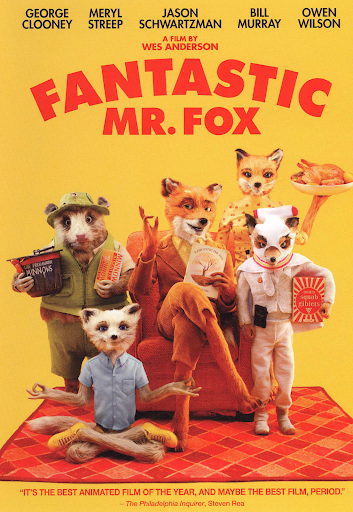Honey, I’m seven non-fox years old. My father died at seven and a half. I don’t want to live in a hole anymore. I’m going to do something about it.
Fantastic Mr. Fox is a 2009 stop-motion film by Wes Anderson that seemed rather unremarkable at its box office premiere. Only scraping earnings slightly past the cost of its budget, few assumed this somewhat uncanny-looking film had more than what meets the eye.
Fortunately, in recent years, social media networks have promoted the movie to a growing number of people, establishing an online status as a classic in twenty-first-century cinema. I believe this movie combines riveting dialogue with uniqueness in style and visually pleasing atmosphere to make this work one of Anderson’s most ambitious and career-defining.
A children’s film, yes, but childish? Fantastic Mr. Fox could be nothing further from it. Delving into intense themes and thought-provoking subject matter, it’s simple enough for kids to enjoy while still presenting the viewer, regardless of age, with an important and well-spoken message.
The film follows the story of Mr. Fox, an ex-farm thief fox turned newspaper columnist and father. His life seems relatively uneventful—dull and poor but happy.
However, this all changes on one unlucky day after he dips his toes back into his old profession and attempts one last grand heist against the three meanest farmers in the entire valley: Bogus, Bunce, and Bean.
Forced underground in hiding following this robbery gone wrong, Mr. Fox’s family and the other animal townsfolk he roped into this unfortunate encounter must now come up with a solution for their situation or surely face grave consequences.
While on paper this outline sounds grim, it’s lighthearted and played for laughs in reality. The movie surely has serious, down-beat moments, but it is adapted from a children’s book, after all. You most likely know the author of the original book, Roald Dahl, from some of his works, such as Charlie and the Chocolate Factory, as well as James and the Giant Peach, two other children’s books that have also been turned into films.
Wes Anderson stays relatively close to the source material in his film, taking a few adaptive liberties here and there. Though most aspects of both pieces of media are alike, the book focuses more heavily on the conflict between Mr. Fox and his son.
A core theme of the film and original story is the importance of family. Mr. Fox and his wife have a balanced, wholesome marriage together. As the story progresses, their relationship strains, especially during the times when he becomes careless and puts his interests before those of others. Regardless of all these struggles and hardships, the Fox family stays together and can ultimately overcome whatever life throws at them. Mr. and Mrs. Fox’s son, Ash, is what ultimately holds the two of them together. He is not without flaws, however. Far from it.
Ash is not your typical tween boy. He is lost, alone in a world that seems to reject him at every opportunity it can take. He’s different. What makes his situation even worse is his cousin, Kristofferson, or Kris, who comes to stay with Ash and his family. Kris is also not your typical tween boy either; instead, he is incredibly talented in many different areas, particularly athleticism, which Ash envies greatly.
This dynamic of an outcast and rebellious Ash contrasting the cool and gifted Kris plays out in many scenes of relatable feelings regarding angst and isolation.
Beyond its great narrative, Fantastic Mr. Fox’s visuals are, like most of Wes Anderson’s work, incredible. With comprehensive color palettes and an excellent selection of scenes and camerawork, the movie is easy on the eyes and uplifting.
The movie’s stop-motion filming, to me, is not groundbreaking nor unique, but instead represents the best the genre has to offer. With its intentional, carefully crafted set design, thoughtful characters, and flawless scenery, Fantastic Mr. Fox shows more than it tells. Each uncanny expression, ruffled piece of fur, and questionable animated sequence breathes life into the film, giving it the fluidity it needs to stand as an excellent movie.
One of Fantastic Mr. Fox’s lesser-discussed major strengths, in my opinion, is its incredibly impressive voice acting. The expressive dialogue is brought to life beautifully through the talented work of several A-list actors and careful creative direction. This, coupled with the wonderful sound design, makes for an immersive and enjoyable listening experience.
The movie sprinkles quite a bit of witty humor into some of its scenes, setting up enjoyable two-sided dialogue sequences or cleverly crafted visual gags with ease. Though the stakes are high, Fantastic Mr. Fox doesn’t overdo the tension of its conflict and keeps things at a manageable, easy-going pace.
One of my favorite recurring bits is the liberties taken through the medium of stop-motion, taking place in scenes such as Mr. Fox devouring an entire plate of breakfast in less than a second—something which obviously would be much harder and possibly less humorous in a live-action film.
Wes Anderson’s signature cinematic style is very visually prominent here, establishing the same symmetrical and color-coordinated design one would expect from any of his
works. The technicalities of the stop-motion field allow the creative minds behind Fantastic Mr. Fox to take this style to the next level, building scenes and sets that would be impossible to recreate in real life. These pre-colored and meticulously measured miniatures are then only further amplified by professional filter choices and intelligent camera placement, creating an atmosphere unlike any other.
Fantastic Mr. Fox is, more than anything, a joy to watch.
The entire runtime is filled with fun, constantly providing the viewer with engaging material and being a more-than-pleasant experience overall.
If you haven’t already, go watch it. If I had to choose a single word to summarize this film—it’s excellent.
